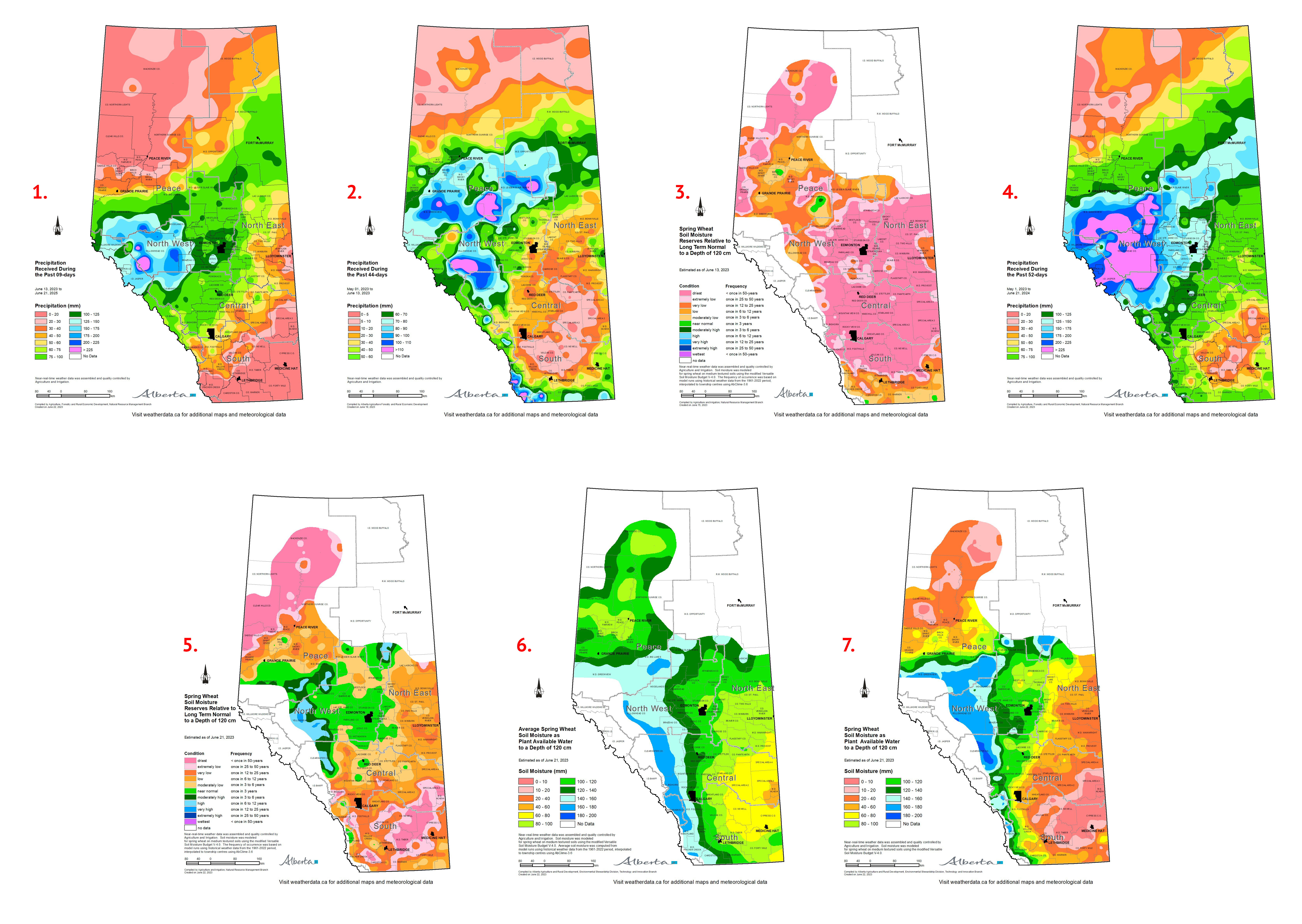Moisture Updates - June 21, 2023
Synopsis
Map 1: Since June 13, significant rains have fallen across a wide area of the province, from roughly Calgary in the south, extending as far north as the Southern portions of the Peace Region (Map 1). Much of the Northwest Region was inundated by rain, with 38 stations reporting more than 150 mm of rain and four reporting more than 250 mm. The greatest amount (326 mm) was reported by the Luscar Creek Station, but this remains unverified at the time of writing.
In sharp contrast, many previously very dry areas across the Northern Peace Region along with parts of the Southern Region and Eastern portions of the Central region, received little or no rain and remain in immediate need for moisture.
Moisture Conditions since May 1, 2023
Maps 2, 3 & 4: May and early June proved to be very hot and dry. By June 13, there were large areas that had received less than 30 mm of moisture (Map 2: Medium Orange) and were in desperate need for rain. Notably this included lands from Lethbridge in the South all the way to Cold Lake in the North, and across the Peace Region. Lands roughly North of Manning were in a similar situation. Within these areas, some lands had received less than 10 mm of moisture and soil moisture reserves through most agricultural areas were sustained at near one in 50-year lows (Map 3).
With the rains over the past several days, The situation has changed dramatically for most of the provinces growing areas, with the exception of the Northern Peace Region and large area extending from just Northeast of Lethbridge upwards through to at least Oyen, where less than 40 mm has fallen in the 52 days since the beginning of May (map 4). This coupled with low soil moisture reserves and warmer than average temperatures has resulted in very difficult growing conditions.
Soil Moisture Reserves Relative to Normal, as of June 21, 2023
Map 5: Soil Moistures reserves (Map 5) have returned to at least near normal now across a large portion of the Northwest Region, and across many agricultural lands, they have recovered from the 1 in 50-year lows that were depicted across much of the province (Map 3). However there are still large pockets of 1 in 50-year lows remaining across many parts of the Peace Region and large swaths of the Southern Region (Map 5). Note that in those areas in the North West region where soil moisture reserves are in excess of once in 6-year highs, much of the land is quite wet and now has diminished capacity to absorb further moisture. As a result they are now have an elevated flood risk in the event of further heavy rains.
Perspective
Maps 6 & 7: Mid-June typically marks the time when on average, soil moisture reserves are at their highest levels in the year (Map 6) and as such, one in 50-year lows depicted on Map 5, do not mean they are necessarily near zero. It simply means they are deeply depleted relative to normal and extremely reliant on timely rains. Current reserves (estimated for a spring wheat crop with a rooting depth of 120 cm) are shown in Map 7. Those areas with less than 40 mm of moisture (dark orange to pink) are still in immediate need of rain now and those areas in pink have little to no reserves left.
It is difficult accurately infer crop conditions from these maps as the temperature, timing and amount of rainfall plays a critical role in crop growth when plants are stressed for moisture. In addition, thunderstorm activity is not always accurately represented by the current network of stations, and there are many reports of local “spotty” conditions showing up as poor growth, uneven germination, and elevated insect activity. Locally some crops are doing relatively well in some areas and 'just down the road or over the hill' the crops are not faring well. This weeks crop report will be out on Friday, June 23, 2023 and it will shed light on crop conditions in these areas that are remaining dry. Furthermore, the effects of recent rains on crop condition won’t be known immediately, and it many cases it may not be until harvest time that we will be able to accurately quantify what effects the early season moisture deficits had on crop yields.
Contact Us
Saddle Hills
Junction of Hwy 49 & Secondary Hwy 725
RR1, Spirit River AB
T0H 3G0
T. 780-864-3760
Fax 780-864-3904
Toll-free 1-888-864-3760
frontdesk@saddlehills.ab.ca
Sign up to our Newsletter
Stay up to date on the Saddle Hills activities, events, programs and operations by subscribing to our eNewsletters.

